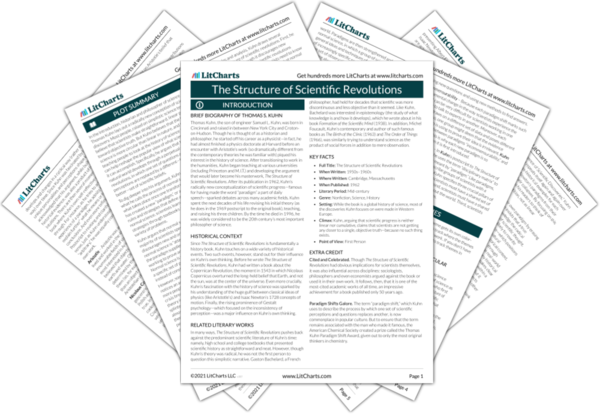Nicolaus Copernicus Quotes in The Structure of Scientific Revolutions
When acute, this situation is sometimes recognized by the scientists involved. Copernicus complained that in his day astronomers were so “inconsistent in these [astronomical] investigations . . . that they cannot even explain or observe the constant length of the seasonal year.” “With them,” he continued, “it is as though an artist were to gather the hands, feet, head and other members for his images from diverse models, each part excellently drawn, but not related to a single body, and since they in no way match each other, the result would be monster rather than man.” Einstein, restricted by current usage to less florid language, wrote only, “It was as if the ground had been pulled out from under one, with no firm foundation to be seen anywhere, upon which one could have built.”
What occurred was neither a decline nor a raising of standards, but simply a change demanded by the adoption of a new paradigm. Furthermore, that change has since been reversed and could be again. In the twentieth century Einstein succeeded in explaining gravitational attractions, and that explanation has returned science to a set of canons and problems that are, in this particular respect, more like those of Newton’s predecessors than of his successors.
Looking at the moon, the convert to Copernicanism does not say, “I used to see a planet, but now I see a satellite.” That locution would imply a sense in which the Ptolemaic system had once been correct. Instead, a convert to the new astronomy says, “I once took the moon to be (or saw the moon as) a planet, but I was mistaken.”

Nicolaus Copernicus Quotes in The Structure of Scientific Revolutions
When acute, this situation is sometimes recognized by the scientists involved. Copernicus complained that in his day astronomers were so “inconsistent in these [astronomical] investigations . . . that they cannot even explain or observe the constant length of the seasonal year.” “With them,” he continued, “it is as though an artist were to gather the hands, feet, head and other members for his images from diverse models, each part excellently drawn, but not related to a single body, and since they in no way match each other, the result would be monster rather than man.” Einstein, restricted by current usage to less florid language, wrote only, “It was as if the ground had been pulled out from under one, with no firm foundation to be seen anywhere, upon which one could have built.”
What occurred was neither a decline nor a raising of standards, but simply a change demanded by the adoption of a new paradigm. Furthermore, that change has since been reversed and could be again. In the twentieth century Einstein succeeded in explaining gravitational attractions, and that explanation has returned science to a set of canons and problems that are, in this particular respect, more like those of Newton’s predecessors than of his successors.
Looking at the moon, the convert to Copernicanism does not say, “I used to see a planet, but now I see a satellite.” That locution would imply a sense in which the Ptolemaic system had once been correct. Instead, a convert to the new astronomy says, “I once took the moon to be (or saw the moon as) a planet, but I was mistaken.”











